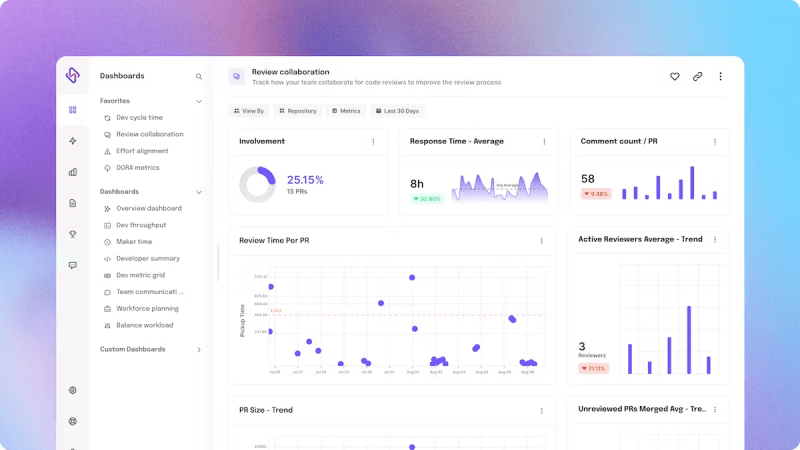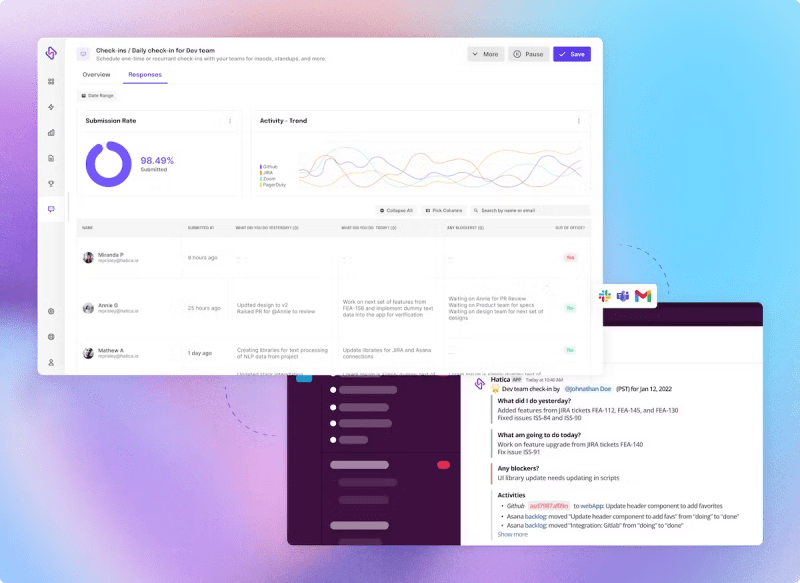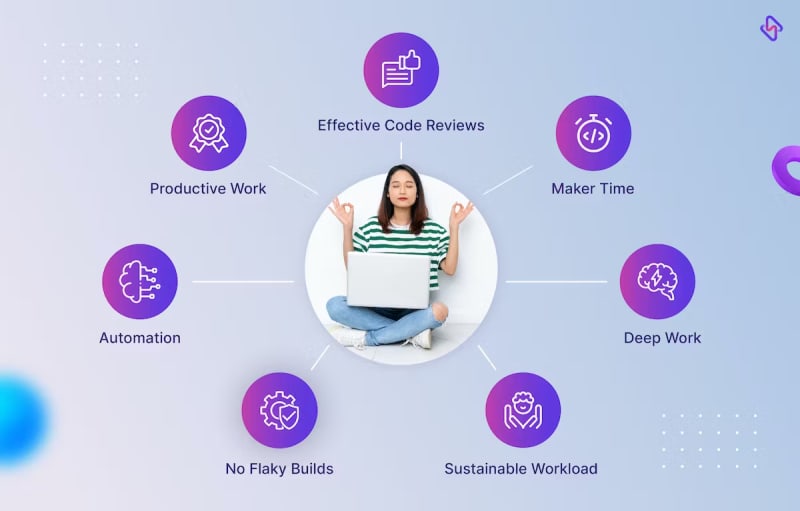Software development is a fiercely competitive and tight space. As you read this blog, thousands of features have already been worked on, and rolled out by devs globally. And that’s where implementing DevOps best practices becomes a move of utmost importance.
Why Should You Streamline Your DevOps Strategy?
Everyone, and anyone in the software world knows about what DevOps brings to their table; for starters, upto 66% increase in innovation, 64% better service quality, and a whooping 70% improvement in software delivery.
DevOps help teams to develop, deliver, and maintain high-quality software products through a harmonic collaboration between development and operations teams. A solid DevOps culture is a north-star for development teams today; however, not every organization is able to reap its benefits, despite much willingness.
Engineering teams are willing to scale their DevOps journey; however, they lack a clear roadmap in adopting and implementing it across the spectrum. The reasons are plenty- right from a broken SDLC, to inter-team frictions, and communication debt. DevOps does sound like a simple amalgamation of engineering and operations, but in real-time, it is highly complex and needs regular process iterations, especially in a fast-paced development environment.
5 Things DevOps Teams Should Do to Stay Ahead!
While engineering teams are still figuring out the best implementation strategies, here are topmost 5 things DevOps teams should do for solid software development.
1. Combining Agile and DevOps Together
Traditionally, DevOps and Agile have been considered two parallel approaches with no intersection point, when it comes to software planning and development. Regardless of what’s been said and done so far, the merger of two methodologies can help teams realize both micro and macro goals of their development process.
Integrating DevOps with sprint planning can help managers to overcome their biggest inter-team challenges: communication debt stemming from lack of visibility of who does what. Logging work of your DevOps team in upcoming sprints, and realizing their sprint-over-sprint trends, discussing operability, and service backlog (with product) can help teams to be on the same page about how the whole development process is churning out.
Sprints need to move beyond product discussions, and strive to explore operational functionalities as well. Inviting DevOps teams to your sprint jamming can help generate continuous and faster iterations so no build and ship timelines are missed, despite external variables. That’s how the ops squads can support devs in orchestrating a solid feature release schedule, with faster product shipping, and greater accuracy.
2. Optimizing the Feedback Loop
Feedback- be it within teams, or via customers should be at the core of planning to deliver engineering excellence. Unfortunately, the traditional feedback and review process is often tagged painful, and more so, most teams consider code review a secondary task that can be performed in the background. .
However, here’s the catch; Trying to deliver better in future without understanding where and why they failed in the past can be counter-productive. Conducting regular code reviews are not just necessary, but inevitable for delivering quality code and a masterpiece as the end product. It is far-fetched to expect teams to adopt code review practices in one go, especially with so much pressure mounting on them to create faster release pipelines. However, with the right tools, practices, and some accountability, the process becomes smooth, with reduced back and forths.
Hatica’s review collaboration dashboard supports DevOps teams in streamlining their review flow by bringing all stakeholders at one place, and filling gaps in assigning, completing, and closing current review pieces. Moreover, EMs and team leads can ensure all team members are involved in the review process through the involvement metrics. It helps leads visualize the horizontal distribution of code, so reviews are spread evenly within teams.
Once the internal feedback process is rationalized, DevOps teams need to take the same approach forward to final consumers of their product. That’s how teams can even reduce the time to market for new features and ensure the best possible experience for both customers and developers.
3. Using The Right Metrics to Track and Improve CI/CD Pipelines
Continuous improvement is the backbone of DevOps philosophy, period. And that’s where tracking, and acting on key DevOps metrics come into the picture.
There goes the saying- the faster the development environment, the more susceptible it is to SDLC challenges. Tracking metrics helps teams to track down issues faster, way before they spiral into something worse and takes the whole team down.
Google’s DORA metrics track the four delivery indicators for DevOps team, with a balance between velocity and software stability. However, the four indicators alone cannot help to figure out their CI/CD bottlenecks. It’s a common pitfall most DevOps teams keep facing, without digging deeper into ‘how’ to leverage and customize metrics for themselves. Using additional metrics, like cycle time, code churn, review time, and progress status, alongside DORA empowers teams in their ‘continuous evolution and iteration’ journey.
Industry-accepted frameworks, including DORA and SPACE approach are the litmus paper to your project’s health, and overall developer happiness. Each team is different, and so are their challenges, working methodology, build environments, and project releases. And centralized metrics tracking might not be the only solution teams are looking for.
Another way for DevOps teams to make most of these given resource metrics is to set self-imposed development milestones. Teams can do so by combining response time, or PR size with IC maker time, and Average LoC. For example, limiting LoCs to just 200 at a time for all devs, and getting notifications everytime the LoC breaches the mark can help teams to streamline their code quality, and even improve code reviews inter-teams.
This way, you can track, and monitor the exact performance of your development culture and pursue DevOps excellence.
4. Adopting Async Work Culture
This is a new one, and a clear demarcation from the conventional standup culture, and daily status updates meetings. Globally, unproductive meetings cost organizations $37 billion, and 24 billion hours of work each year. Other statistics are equally staggering; around 71% of these meetings are tagged ‘unproductive’, and even 58% of meetings lasting more than 30 minutes. It doesn’t mean we completely weed out synchronous catch ups from work schedules; but keep doing the same thing, and expecting different results isn’t sustainable, and even insanely (as Albert Einstein quotes).
Async culture isn’t a substitute for synchronous meetings; rather it compliments scheduled catchups, by filtering the noise and transferring ‘status updates’ into meaningful discussions. DevOps team too bear the brunt of unproductive meetings, and are on the receiving end of product, engineering and operational bottlenecks stemming from lack of deep work time, and constant meetings.
Hatica provides automated check-ins through Slack, email, or the Hatica App to run daily standups. The check-in feature helps teams to be on the same page about work updates, tasks they are working on, and the blockers faced by any IC, along with flexibility for team members to answer the standup at their own pace.
So next time a dev has a code to debug vs an update standup to attend, they know how to manage both, and yet get effective results.
5. Focusing on the Overall Developer Experience
All efforts to implement a top-notch DevOps strategy is futile unless your developers are fully enrolled into the overall engineering vision. Preserving Developer Experience (DX) isn’t just about guaranteeing happy devs, but also ensuring they continuously grow, innovate as individual contributors, take the product to new heights, and unlock super productivity.
DX becomes vital, especially when teams are constantly switching between dev and ops side of development, and facing multiple time-retching handoffs every day. The constant tussle between the two teams gets evident especially in team meetings, and overall engineering discussions.
The future of DevOps closely follows the DX trajectory in a team. A positive DX can help teams realize fewer flaky builds, a pro-developer environment with minimal pre-commits, and seamless hand-offs between dev, ops, and SREs. DevOps is more dynamic than any of its tech counterparts, making teams continuously expand, sometimes at uncomfortable paces. All these changes require teams to enroll and empower developers completely.
Transforming your DevOps techstack, infrastructure, or production environment without accounting for your developer’s comfort and satisfaction, will prove to be an unfateful disaster. Without bringing all engineering teams at one place, engineering leaders cannot move to microservices from monolithism.
Developer experience creates openness, transparency, and mutual recognition of a dev’s work- all pre-requisites of a developer-centric work culture. Only when devs are fully engrossed and in control of their work, engineering leaders can break inter-team silos, and figure out better workflows.
That’s where continuously sustaining DX becomes vital once engineers become part of the ‘larger’ DevOps picture, when they have a positive work experience, they can help companies continuously evolve, grow, and innovate.
What’s Next For Your DevOps Team?
The software landscape is changing. It is not just about creating a better product anymore; rather building a better development process, and enabling your developer talent to generate the highest level of customer satisfaction. Implementing DevOps the right way helps organizations to surpass their competition with faster updates, increased reliability, improved scalability, cost savings, and improved overall experience.
At its heart, DevOps is all about continuous improvement- in terms of software delivery, velocity, and the overall team happiness, and well-being. Implementing these best practices will give your organization a much-needed edge in today's evolving digital landscape, and should be a top priority for engineering managers.
Teams need to understand that DevOps cannot be implemented overnight, but with the right tools, the whole process looks more hassle-free, and doable. Schedule a demo today to learn how Hatica’s engineering analytics platform can help you build a super productive DevOps environment, through continuous improvement, continuous building, and most importantly, continuous collaboration.






Top comments (0)